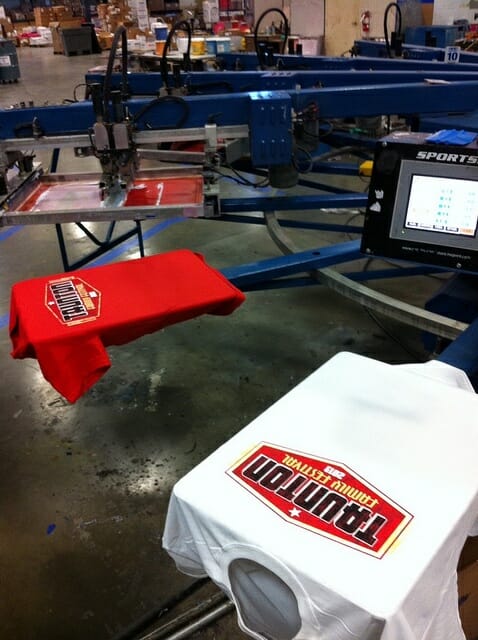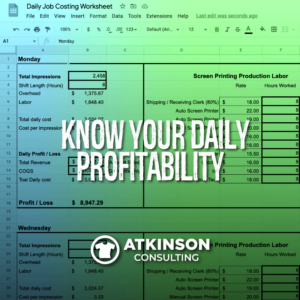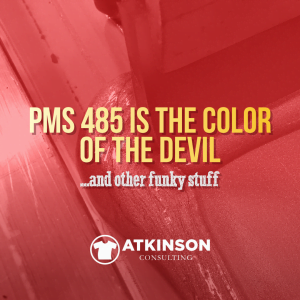I’m frequently seeing more discussions online regarding local competition undercutting business by quoting or taking jobs at discounted rates. Having competition in your market is a good thing, and at the heart of it seems very American. However, having your customer base suddenly dry up because another company is slashing their rates seems shockingly unfair and can get anyone’s blood boiling quickly. So what’s going on here and what can you do about it?
There are a few things at play here that we should start to dissect. First, there’s the notion that someone is offering the same services as you, but doing it drastically cheaper – so they win the order. Often, it’s not a case of apples to apples as they may not be using the same garment blank, the number of screens or even breaking out the price the same way (you include screens, theirs is a separate add-on later). If it’s not too late, make sure your potential customer is educated on the quoting process and all things are comparable. Secondly, there’s also the fact that maybe the guy down the street isn’t dropping his pants at the price and trying to steal all your business but legitimately has reduced his margins enough that they can operate with lower pricing and still make a good profit. Don’t just naively assume that your costs and overhead are equal to your competition. All shops are not created equal.
Next, I’d like to introduce you to the notion that you shouldn’t be selling on price anyway. Maybe you’ve heard or read this before, but it’s dramatically true. Price based sales reduce the services you provide down to a bare-bones commodity, like gasoline. Think about all the creative energy, craftsmanship, years of learning the printing process – all shoved down through a hose and into someone’s tank like gas, sold for the lowest price imaginable. Who the hell wants to do that? The flipside of the coin is that your customer base revolves around clients that truly appreciate what you have to offer, are there for the long-term, and in fact, wouldn’t dream of going anywhere else because they value everything you have to offer. Your price is whatever it is, and they will pay for it. At the end of the day Motel 6 and Ritz Carlton are still hotel chains, where complete strangers rent a bed for a night or more. Two different markets, two different business models; but only one sells on price. Are you the “leave the light on” guy? Do you want to be?
So, let’s discuss how to change your thinking a bit. Where you should be driving your thought process is thinking about your Value Proposition. In the simplest terms, a Value Proposition is a statement that outlines the benefit that you provide for your customers and how you do it uniquely well. It describes your target customer, the problem you solve, and why you are distinctly better than everyone else in the marketplace. Think about that. Who do you want to sell to every day? Are you just taking any order from anybody that strolls in off the street? Or, are you explicitly targeting a particular market by aligning your services to their needs? And, to complete the thought, have you built your business to completely dominate that market by offering what other companies can’t? Let’s keep moving and think about your business as you read this:
Define. The first step in building your Value Proposition is to define exactly who you are, and who are your customers. Rather than thinking about any person that could just amble through the door, narrow it down to the core group that you really want to serve. Maybe your market could center on retail, museums, schools, military, resorts, bands, promotional item folks, area businesses, even other printers. It doesn’t have to be one selection…the key is just to define who are your best customers that align with your business skills and talents. These could be future customers too, as maybe they haven’t partnered with you yet. Make a list. (Yes, actually do it you lazy bum!!)
Evaluate. The second step is to honestly evaluate your business. Does it offer a truly unique and demonstratively better offering for your defined target group? If not, what do you need? Better art, better skills as a printer, faster turn times, knowledge in apparel, updated equipment or technology? Be brutally honest. If you are lacking something, what are you going to do about it? Maybe you need to hire or outsource an artist, take a class, add embroidery, or buy a delivery van. This could be a goal while you work towards filling the void, but the main idea here is to identify what you are lacking and have a real plan in place to shore that part up if needed. Again, write it down!!
Measure. You can’t manage what you don’t measure. You’ve heard that before, right? It’s important to grasp all the factors in your company to truly understand what’s happening. How often do you look at past sales history, production numbers, or overhead costs? Do you normalize your costs to drill down to what your cost per impression may be? When you think or talk about reducing your operating costs, do you know where to start? Do you know where your sweet spot is on orders – meaning what would be your most profitable type of sale? Getting all this information together and spending some time analyzing it isn’t just so you can’t get your inner geek fired up. It’s crucial to understand the baseline of where and how your business operates so you can make some good decisions for the future. If you know all this information like the back of your hand, you won’t sweat the small stuff like watching the price shopper guy walk away. That order was a loser, and you’d rather cram your schedule full of more profitable jobs, with guess what? Orders from your customers centered on your Value Proposition. If your schedule is full of customers who pay you more, will send future orders your way, and champion your services to other people, would you honestly care if another shop quotes the guy $1 or $2 less?
After you’ve gone through the mental exercise of Defining, Evaluating and Measuring it’s time to spend a few minutes building your Value Proposition for your shop. If you’ve done your homework this is easy. It’s just a basic “fill in the blank” sentence. Try it.
For (Your Target Market) who needs (The Type of Decoration/Service) (Name of Your Shop) offers (Your Unique Capability/Service/Advantage) and this is important because (List Why It Solves a Problem).
The idea here isn’t to make a complete sentence, so if your thoughts or words don’t exactly fit it’s ok. Reword it so it sounds better. The key takeaway is to have at least one phrase that you can use to talk to people to build your shop’s business and not engage in the price war. What do you offer that makes you unique, and why is it important to your customer? This is the reason people will seek you out, hand over their money, and tell all of their friends…not because you are cheaper. It’s ok to have several Value Propositions too. Don’t just think you only have to have one.
At the end of the day, it’s the value that you create that adds more money to the order. How you demonstrate this value should be in every conversation, on your webpage, in all marketing communications, essentially everywhere. Don’t keep it a secret. Scream it from the rooftop instead.





7 comments
Jonas
I have to respectfully disagree. You mentioned two hotels as an example. Those hotels are priced based on an experience for the night. The great majority of customers just want to get shirts done. It doesn’t matter if the guy printing it has 6 months experience or 60 years. It doesn’t matter whether they have a $3K manual press or a $75K automatic. They just want shirts. I have also seen that they want them as cheap as they can get them. I can’t tell you how many times in a week a customer will pass on the quote we gave them because they can get it for .25 cents per shirt less down the street. Do you not think I will drop the price? When your customer is calling you from California and you are in Texas giving them a shop tour and showing them your $100K set up is just not an option. Your post is nice in theory but this industry is changing (has changed). There are a couple national companies (not mentioning names) that have raped the process and created a whole new “bottom line price” mentality. If shop owners aren’t hip to this they will start seeing more and more customer walking away. What gives a shop :value” is the experience behind the squeegee, superior quality control (no miss prints, finger prints) great customer service, and a quick turn around. Yeah…like every shop out there will admit to offering anything less. Then, when all things are equal. It’s all about the price. 🙂
atkinsontshirt
Jonas:
Thanks for commenting!! I respect your opinion and career experience. It’s ok to disagree with me, as how you do things probably differs from mine. Different shop, different clients, different experiences.
However, the point of the article was about developing the shop mindset to sell on value, rather than price…and finding the book of clients that appreciate what you offer.
There’s ALWAYS a shop that will do it cheaper. That doesn’t mean it’s better. Or faster. Or more creative. Or with better quality. Or with a better service experience. Or with the ability to solve some customers problem. That’s the difference.
The trick is to figure that part out and make it work for you.
Jonas
Thank you for that response. The problem with building a customer base built on value is the great majority of custom tshirt orders are event type shirts that will be worn once or twice and end up at goodwill. Or, they are work shirts worn for a few months and then discarded. Most customers care about the price first and foremost. This is why the VERY first question we hear as a screen printer is….How much would it be for?.. Then the second thing out of their mouth is, I only want a few words real small on the chest is it any cheaper? This is also why the great majority of work is one (1) color. They don’t want to pay any more than they have to. I have NEVER heard a customer ask how is the quality of the print going to be? The quality of the shirt, yes, but the print – no. Unfortunately in 2014 screen printing tshirts is a price based game (in MY opinion) if you are not competitive, you are not selling shirts. I only respond back because the post you made is about trying to sell the value of your company; and I’m assuming you are doing this to be able to charge more. The truth is (IMO) today’s customer could care less about the value you try and sell them. They want the cheapest price and that’s all. Thanks again for the convo!!
atkinsontshirt
Jonas:
Not all screen printers print for the same target market as yours. Personally, my customers are different from yours. We don’t print one color, event driven throw away shirts. Are we competitive on pricing? Yes, of course. Are we the cheapest? Hardly ever. What we sell every day is trust. We are contract apparel decorators, and we embroider, screen-print and digitally print. Our customers trust us because we deliver on time, with high quality, with very intense demands. There is a cost for doing it right, and while we are competitive, we don’t give away the store at the same time. We do sell value. Every day. Maybe you are focusing your efforts on the wrong market? Just a thought… Here’s my Pinterest board that shows what and how we do things. Check it out… http://www.pinterest.com/atkinsontshirt/behind-the-curtain-at-a-t-shirt-shop/
Jonas
Well said, and BEAUTIFUL Pinterest board!! I hear what you are saying and I can only assume if a customer is shopping online, as more and more are doing, they will pass you by. I agree, I seem to be targeting a different market. Either way, all things said: all things good. Much continued success to you!
atkinsontshirt
Jonas:
As an example of what I’m talking about, we’ve spent the last few years building our Ink ot the People website. This is an ENTIRELY different business model than Visual Impressions. We needed to compete online, and this is the engine we built to do that. Check it out – http://www.inktothepeople.com
Jonas
Awesome! Again, much success. Thanks!!